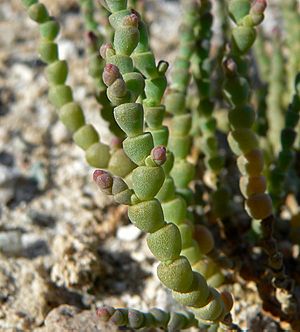Iodine bush facts for kids
Quick facts for kids Iodinebush |
|
|---|---|
 |
|
| Scientific classification | |
| Genus: |
Allenrolfea
|
| Species: |
occidentalis
|
| Synonyms | |
|
|
The iodine bush (scientific name: Allenrolfea occidentalis) is a small, low-growing plant. You can find it in the Southwestern United States, California, Idaho, and northern Mexico. This plant loves to grow in sandy, often salty, and very alkaline soils. Think of places like desert washes or dry lakebeds that have a lot of salt. It's a special kind of plant called a halophyte, which means it can live in salty environments. It's often found in alkali flat ecosystems.
What the Iodine Bush Looks Like
The iodine bush has green stems that look a bit bumpy or "knobby." These stems are also "fleshy," meaning they are thick and hold a lot of water. The stems appear to have "joints" or sections, like a string of beads. These joints are called internodes. Sometimes, the sections are so short that they look almost round.
Instead of typical leaves, the iodine bush has small, flat scales. These scales are scattered all over the surface of the stems. The plant's scientific name, Allenrolfea, honors an English botanist named Robert Allen Rolfe.
Historical Uses
Long ago, the seeds of the iodine bush were an important food source. People in North America used these seeds for food in prehistory, which means before written records were kept.

